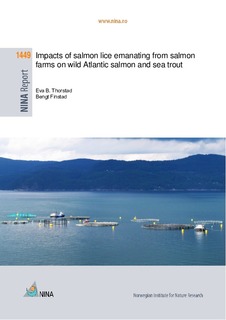Impacts of salmon lice emanating from salmon farms on wild Atlantic salmon and sea trout
Research report

Åpne
Permanent lenke
http://hdl.handle.net/11250/2475746Utgivelsesdato
2018Metadata
Vis full innførselSamlinger
- NINA Rapport/NINA Report [2341]
Sammendrag
Thorstad, E.B. & Finstad, B. 2018. Impacts of salmon lice emanating from salmon farms on wild Atlantic salmon and sea trout. NINA Report 1449: 1-22.
Results from scientific studies on the impacts of salmon lice on Atlantic salmon and sea trout are summarized here. Considerable evidence exists that that there is a link between farm-intensive areas and the spread of salmon lice to wild Atlantic salmon and sea trout. Several studies have shown that the effects of salmon lice from fish farms on wild salmon and sea trout populations can be severe; ultimately reducing the number of adult fish due to salmon lice induced mortality, resulting in reduced stocks and reduced opportunities for fisheries. Depending on the population size, elevated salmon lice levels can also result in too few spawners to reach conservation limits.
Salmon lice are external parasites on salmon and trout at sea. They feed on fish’s mucus, skin and muscle. Mortality due to salmon lice primarily occurs in young fish after they enter the sea from fresh water (11 mobile lice per fish is lethal level for a 15 g wild salmon), but severely infested sea trout can also die from salmon lice later in life. Mortality occurs because salmon lice can cause severely damaged fins and skin lesions, and thereby physiological stress, problems with salt regulation, increased susceptibility to other infections and reduced disease resistance in individual fish. Salmon lice can also cause reduced swimming performance, feeding and growth and altered behaviour of the fish.
Salmon farming increases the spread and abundance of salmon lice in marine habitats, and thereby the risk of infection and mortality among wild salmon and sea trout in areas with fish farms. These facts are both verified by field monitoring of salmon lice on wild fish and by the fact that salmon lice on wild fish in farm-intensive areas have lice with the same resistance to chem-icals as used in farms. Wild fish in farm-free areas generally show low lice levels. In farm-inten-sive areas, lice levels on wild fish are typically higher, but variable. With the expansion of fish farming, marked salmon lice outbreaks on salmonids have been reported from Canada, Ireland, Norway and Scotland.
Studies indicate an annual loss of 50 000 adult wild Atlantic salmon to Norwegian rivers because of salmon lice, which corresponds to an overall loss of 10% of the wild salmon because of salmon lice on a national level (i.e., including both farm-free and farm-intensive areas, based on data from the years 2010-2014). Salmon lice from fish farms are identified as one of the two largest threats to wild salmon in Norway.
Population-level effects of salmon lice in Ireland and Norway have been quantified in large-scale studies in nature by comparing the survival of individually tagged fish chemically protected against salmon lice with untreated control fish. These studies show that lice-induced mortality in farm-intensive areas can lead to an average of 12-29% fewer adult salmon. To exemplify this loss, a 20% reduction due to salmon lice in a river where 4000 Atlantic salmon spawn each year equals a loss of 800 spawners, which means that 3200 salmon spawners will return to the river in a given year instead of 4000. Mortality of sea trout is likely to be higher than in Atlantic salmon, because unlike the ocean-migrating Atlantic salmon, they usually remain in coastal waters, where fish farms are situated.
There are a large number of scientific studies on the impacts of salmon lice on Atlantic salmon and sea trout, ranging from laboratory and field investigations of the effects of salmon lice on individual fish, to analyses of impacts on wild populations. There is year-to-year and local varia-tion in the population effects of salmon lice, and abilities to estimate effects in different areas depend on sufficient resolution of the monitoring of wild fish and salmon lice levels.
Utgiver
Norsk institutt for naturforskning (NINA)Serie
NINA Report;1449Opphavsrett
© Norwegian Institute for Nature Research The publication may be freely cited where the source is acknowledgedBeslektede innførsler
Viser innførsler beslektet ved tittel, forfatter og emneord.
-
Timing is everything: Survival of Atlantic salmon Salmo salar postsmolts during events of high salmon lice densities
Bøhn, Thomas; Gjelland, Karl Øystein; Serra-Llinares, Rosa Maria; Finstad, Bengt; Primicerio, Raul; Nilsen, Rune; Karlsen, Ørjan; Sandvik, Anne Dagrun; Skilbrei, Ove Tommy; Elvik, Kristine Marit Schrøder; Skaala, Øystein; Bjørn, Pål Arne (Journal article, 2020)1. Atlantic salmon in aquaculture act as reservoir hosts and vectors of parasites like salmon lice and this parasite is shown to harm wild salmonid populations. 2. In this study, n = 29,817 tagged Atlantic salmon were ... -
Selection against individuals from genetic introgression of escaped farmed salmon in a natural population of Atlantic salmon
Wacker, Sebastian; Aronsen, Tonje; Karlsson, Sten; Ugedal, Ola; Diserud, Ola Håvard; Ulvan, Eva Marita; Hindar, Kjetil; Næsje, Tor (Peer reviewed; Journal article, 2021)The viability of wild Atlantic salmon populations is threatened by genetic introgression from escaped farmed salmon. Farmed Atlantic salmon are genetically improved for important commercial traits and a life in captivity ... -
Oppvandring og fordeling av laks i Osenvassdraget i Molde kommune: Resultater fra undersøkelser i 2014
Ulvan, Eva Marita; Bremset, Gunnbjørn; Aronsen, Tonje; Thorstad, Eva Bonsak; Solem, Øyvind; Økland, Finn; Havn, Torgeir Børresen (NINA Rapport;1184, Research report, 2015-07-01)Ulvan, E.M., Bremset, G., Aronsen, T., Thorstad, E.B., Solem, Ø., Økland, F., Havn, T. B. 2015. Oppvandring og fordeling av laks i Osenvassdraget i Molde kommune: Resultater fra undersøkelser i 2014. - NINA Rapport 1184. ...